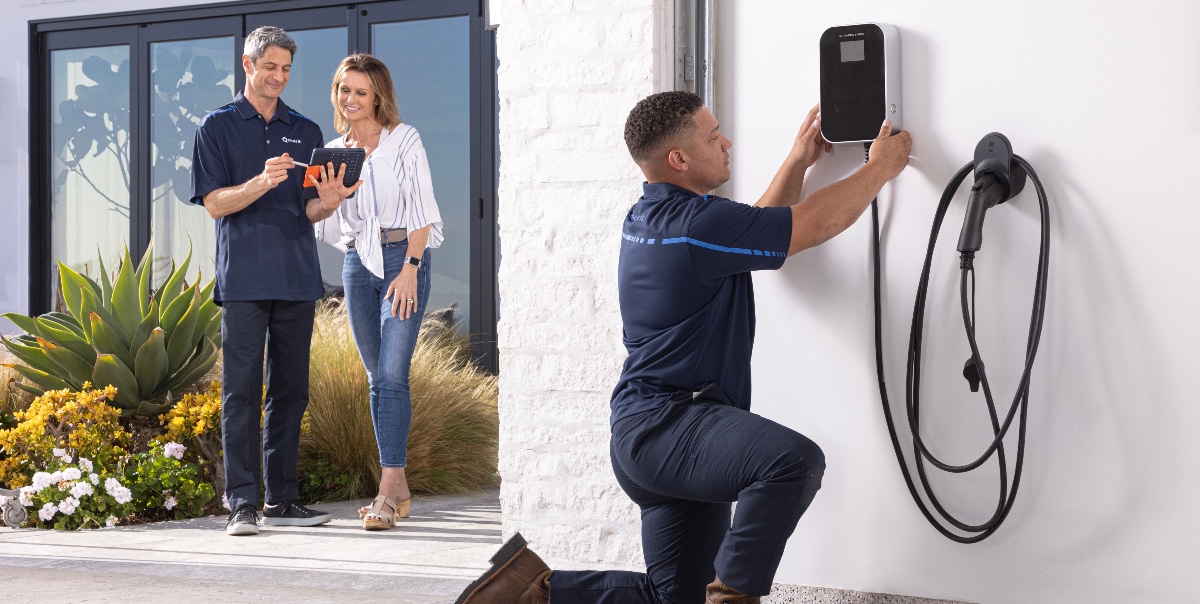5 Benefits of an At-Home EV Charging Station Installation

6 Min. Read
You love driving your electric vehicle, but probably do not like having to search for or wait at a public charging station. You’ve probably want to install an EV charging station at home but aren’t completely sure what all the benefits would be. For a homeowner or a multifamily resident, the value of an EV charging station installation and having the freedom to charge at home increases daily!
Here are five good reasons to install a Level 2 charging station at your home or rental property:
1. More convenient
An estimated 80% of EV drivers reportedly charge their vehicle at home, usually overnight. Those who install an EV charging station at home get in the habit of plugging the car in to charge at night, much like plugging in their cell phone. You won’t need the car (or phone) while sleeping, so you take advantage of the downtime and know you will be fully ready to go in the morning. Additionally, opting to install an EV charging station at home saves you the time involved in traveling to a public charger and waiting — sometimes for hours — while the EV acquires enough range for your needs.
2. Less expensive
Driving an EV was already cheaper per mile than running on gas when gas prices averaged $3.50 a gallon. However, to keep costs down, most people install an EV charging station at home and use it overnight, when electricity costs are lower. Conversely, those using public charging stations are typically using more expensive electricity during the day.
Besides recouping the cost of the electricity, public charging station owners, like all businesses, factor their overhead into their prices. These costs include rent or mortgage payments, the cost of the charging stations, maintenance, and profits. Even free public charging stations at malls, restaurants and other sites cost in terms of time and the fact that you will likely spend money while inside.
Sites with Level 3 DC fast-charging stations charge premium rates for their use. This is partly cost-based since those chargers cost significantly more than Level 2 chargers. A Level 3 EV charging station installation often requires property upgrades to facilitate their 400-V to 900-V direct current connections. Additionally, you are paying a premium rate for the ability to charge your car in about 30 minutes. Level 3 charging costs approximately 25% to 40% more than Level 2 charging.
3. More predictable
You don’t have to worry about waiting in line or getting stuck while charging at nearby public charging stations if you install an EV charger at home. Plug your EV in at your convenience, and program it to charge while you sleep, with the comfort of knowing you will have considerable range in the morning. Your EV undoubtedly came with a Level 1 charger that can be plugged into any 120-volt standard household outlet the charger’s cord reaches. While this charger will not fill most batteries even when plugged in all night, a Level 1 charger will add about 5 miles per hour, which may be adequate for your commute. Better still, if you had a more powerful Level 2 charging station installed at home, plugging in overnight can give you a range of about 250 miles, depending on the battery.
Regular pricing is another element of predictability that home charging offers. Unlike gas prices, which can fluctuate wildly during a year, electricity rates do not change often. You can figure out the rate your utility charges at a particular time of day and calculate your cost per fill-up. Public charging stations are still too new to gauge whether their pricing will be steady or increase for peak times, such as holiday weekends.
4. Better for your battery
EV automakers recommend limiting how often you use a Level 3 fast charger. Studies have found that frequent supercharging can degrade an EV battery faster than lower-level chargers. That doesn’t mean you shouldn’t take advantage when finding a vacant fast charger on a road trip so you can return to the highway faster, but using a Level 3 fast charger has been shown to affect the battery life negatively. Tesla has even programmed its cars to limit charging speeds if they are supercharged too often.
Additionally, it helps if you use a DC fast charger to fill the battery range only to 80%. Fast chargers charge quickly only when your battery’s state of charge (SOC) is below 80%. For the remaining 20%, these units slow down to avoid overcharging. You would be paying for a Level 3 charge at that point, but getting a lower level. It can take almost as long to add the remaining 20% of the amount as it did to reach the 80% level.
It is essential to know your battery type and what is most efficient and effective to extend its life. Not every EV battery can accommodate Level 3 charging.
5. Attracts tenants and increases property value
For property owners, making EV charging stations available is a way to differentiate your building and attract tenants. With most charging at home and many car manufacturers planning to phase out gas-powered cars, those living in multifamily buildings will soon demand an EV charging station installation or move elsewhere. The demand for electric vehicles will escalate considerably in the next year or two.
Real estate giant CBRE noted that it believes EV charging stations will eventually be an expected workplace amenity, like high-speed internet. The same will be true of multifamily properties. Renters, particularly those in more upscale areas and likely to buy new cars, will expect the ability to charge an EV at their complex soon if they do not already. Landlords should take advantage of the opportunity to show they are keeping their properties current to satisfy tenants looking to install an EV charging station at home despite living in an apartment. Besides being more attractive to potential renters, a building with charging infrastructure is likely to be more valuable.
Another reason property owners should act quickly is the availability of tax incentives in many states and cities. The federal government is funding state incentives for EV purchases and EV charging station installations. Incentives vary by jurisdiction and even utility served, but the benefits are considerable. For example, Illinois is introducing incentives that recoup 80% of costs for an EV charging station installation starting in July 2022. Connecticut also has a program offering money for Level 2 and Level 3 EV charging station installations.
Taking action today
The EV boom is here. You are probably noticing more and more EVs on the roads. If you do not have one yet, you may have begun to think about buying one. With so many new models hitting showrooms, deciding on which EV to get may be difficult.
As the largest network of certified EV charger installers in North America, Qmerit is the most trusted EV charger installation partner recommended by automakers, EV charger manufacturers, utilities, businesses, and homeowners alike.
But don’t just take our word for it. Rated #1 in customer satisfaction, Qmerit’s experienced network of certified electricians has installed more than 450,000 EV charging stations in homes and businesses across the U.S. and Canada!
Give us a call at (888) 272-0090 or complete our online EV assessment to find out why we’re North America’s most trusted EV charger installation service provider today!

